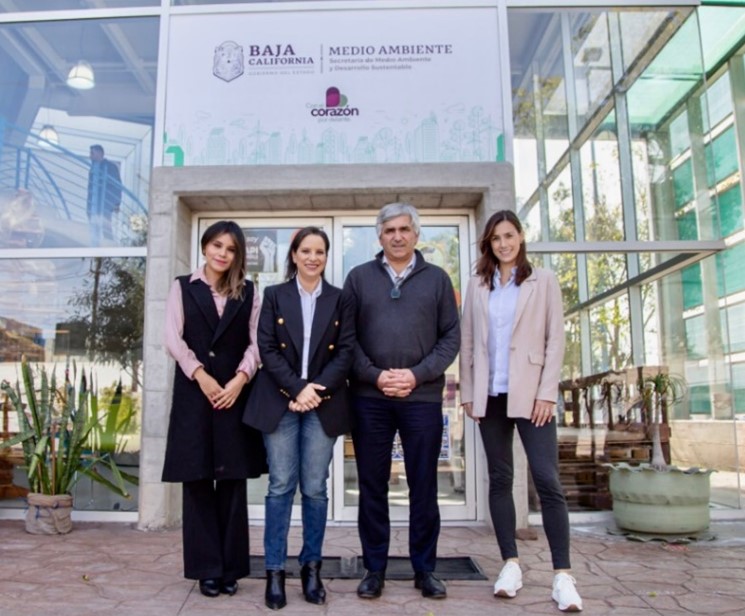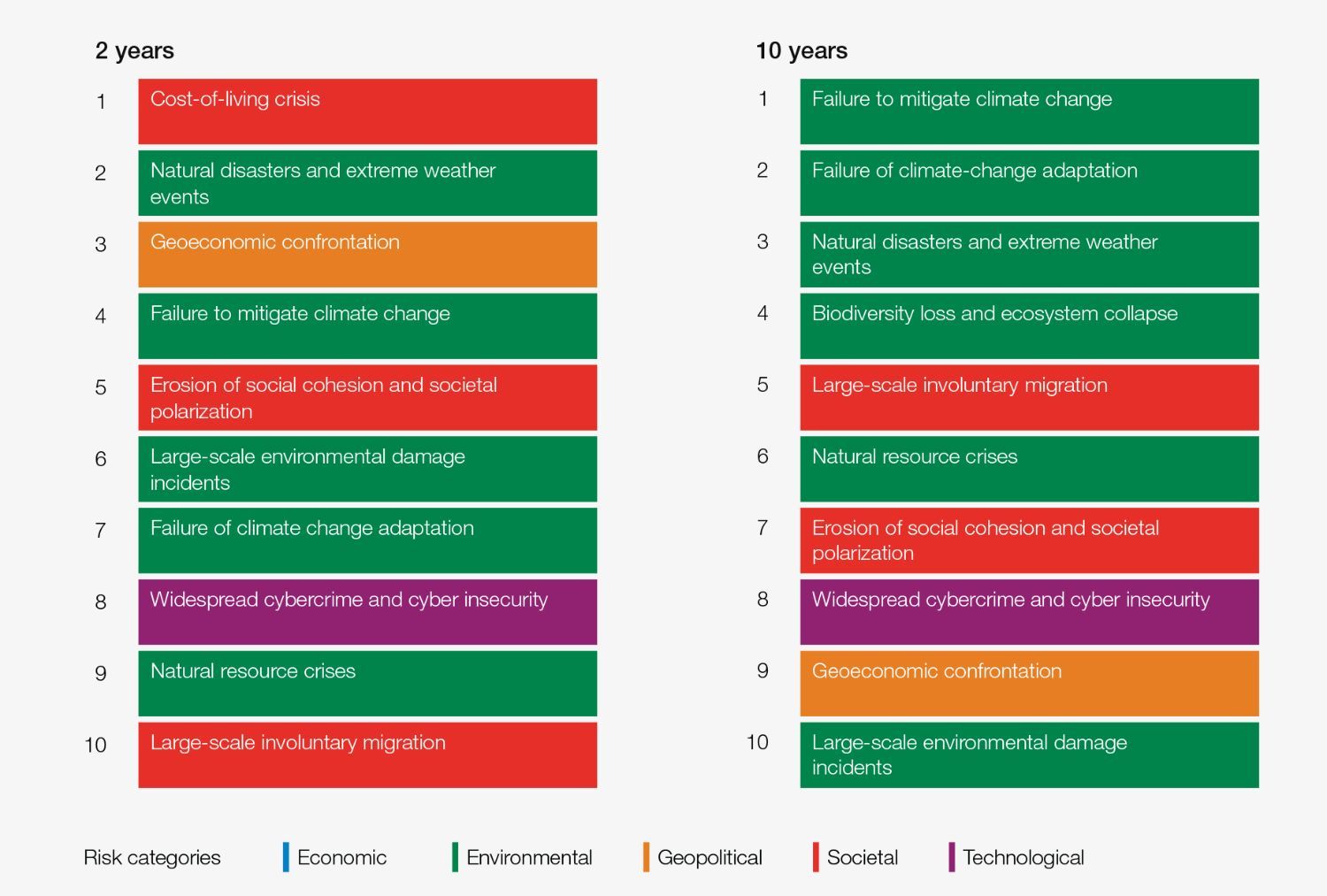|
|
|
|
Welcome back to our readers and happy new year (I guess?)! The World Economic Forum (WEF) 2023-Global Risks Report found, through the results of the latest Global Risks Perception Survey, that the cost of living category dominates global risks in the next two years, and climate action failure dominates the next decade. In fact, 5 out of 10 risks the report maps out in the next two years are environmental, and 6 out of 10 in the next 10 years are environmental. As such, governments, businesses, and communities around the world will be increasingly focused on climate action, the energy transition, and climate resilience—understood both as risks but also as opportunities. The large-scale climate trends that will dominate 2023 global headlines are mostly clear: climate change risks and the road to net-zero; the growing threat of biodiversity loss; and ESG standards and the growing controversy over greenwashing. This naturally leads to a conversation around voluntary carbon markets, and the need for higher integrity and transparency. A new global biodiversity framework reached late last year will set the stage for rising scrutiny on businesses impact on nature and ecosystems, putting pressure on regulators and firms alike. As will greenwashing risks. This means climate regulations and standardized frameworks will gain spotlight. Lastly, the circular economy, sustainable production methods, materials, and supply chains will very likely become more prominent as pressure to increase decarbonization efforts reaches sectors and industries farther than the usual suspects. Welcome back to the Sustainability Dispatch! 
Tania Miranda, EC2 Director |
|
|
|
Las Californias Blue Carbon Initiative |
|
 |
|
|
|
On January 12th, we held a meeting with Monica Vega, Secretary of Environment for the State of Baja California, and Pamela Rodriguez, Director for Climate Change, to discuss how the IOA can assist the state develop a blue carbon strategy—not only by identifying high-value priority areas through modeling, but also through assessing the wetlands and nearby ecosystems’ value added through fishing and other economic activities. |
|
|
|
To continue with this endeavor, we presented the results of our Las Californias Blue Carbon Initiative report, and the modeling of ecosystem services carried out by our Gulf of California Marine Program, at the re-launch of the Wetlands Committee of the State of Baja California. This meeting was held on February 2nd, on World Wetlands Day. It was led by Monica Vega, and multiple academic and civil society organizations took part. You can read more about the meeting and what was said in this article, where the IOA’s work was highlighted. |
|
|
|
|
|
|
|
Ship-borne Marine Pollution |
|
|
|
Continuing with our 2021 and 2022 efforts to bring awareness on the shipping industry’s large ecological footprint, particularly from scrubber’s technology and its residual waters, we held multiple meetings with government officials from the State of Baja California Sur during January and February. With the help of the state’s congressional commission for ecological protection, the IOA will be organizing, along with other local partners, a workshop for authorities to build capacity on this highly technical topic. |
|
|
|
|
|
Rocky Reefs in the Gulf of California |
|
|
|
Towards the end of 2022, the Gulf of California Marine Program (GCMP) coordinated data analysis for the annual Rocky Reef monitoring program. This adds to the 22 years of data the team has curated, allowing scientists to track the health of these valuable ecosystems in the Gulf of California. The latest results show that, while some reefs communities remain stable with healthy biomass levels, others are showing signs of stress. The GCMP will continue to monitor these ecosystems in the hopes of improving our understanding of how natural disturbances and human activities impact these ecosystems. |
|
|
|
|
|
Building a Wider Network for Collaborations |
|
|
|
In early February, the GCMP and dataMares visited Mexico City to promote research collaborations and science communication initiatives. We met and caught up with several UNAM affiliated groups—like UNIVERSUM—and the University’s publishing department, which we had the pleasure of meeting back in November 2022 at the FIL Guadalajara. Finally, we visited the Pabellón de la Biodiversidad to meet the team behind the new academic program “Cátedra UNESCO de Diplomacia Científica y Patrimonio de la Ciencia”. |
|
|
|
|
|
Conservation strategies for the Upper Gulf of California require a new paradigm involving producers, government, academia, and communities to achieve social welfare and protect nature. Don’t miss this op-ed by our own Catalina López-Sagástegui, GCMP’s Director, to read about her thoughts and proposals to help conserve the vaquita marina and the totoaba while supporting the local economy. |
|
|
|
|
|
|
|
Look out for our participation at the 8th Our Oceans Conference to be held in Panama City, Panama, from March 2-3, in a panel hosted by the Charles Darwin Foundation. |
|
|
|
Started by the U.S. Department of State and sustained by a growing community of international hosts and global commitments to action, the Our Ocean Conferences bring together governments and non-state actors to make concrete commitments to protect ocean health and security. |
|
|
|
|
|
Don’t miss this IOA webinar co-hosted with BBA Deals that will feature Evan Van Hook, Chief Sustainability Officer at Honeywell; Claudia de la Vega, Director of Corporate Affairs and Sustainability at Walmart Mexico and Central America, and Gabriel Bustamante, Senior Partner at Bustamante + Freyre law firm and BBA Deals & Disputes Member. |
|
|
|
We will be discussing how and to what extent ESG considerations and future regulations are driving investments and project development in the US, Canada, and Mexico, within a highly dynamic trade scene that is clearly favoring nearshoring in the region. March 22nd • 10am PT (12pm CT/1pmEST) • Free Register here |
|
|
|
Biodiversity and Nature-related Disclosures:
from Standardized Frameworks to Managing Global Biodiversity Risks |
|
|
|
A World Economic Forum report found that nature-positive solutions will create US$10.1 trillion in business opportunities and 395 million jobs through key sector transitions. On the other hand, biodiversity loss can impact businesses through transition, physical, regulatory, and systemic-wide risks that have the potential to impact investment value. However, nature-related investments have historically been overlooked by the capital markets. Similarly, risks brought by biodiversity loss and ecosystem degradation have typically been ignored by businesses and regulators. Just as with sustainability efforts and the transition to net-zero, challenges for businesses to assess and disclose nature-related risks are significant and will take time and capacity building. Here, voluntary initiatives like the Task for Nature-related Financial Disclosures (TNFD) can pave the way for future mandatory disclosures and proper management of risks tied to nature degradation and biodiversity loss. |
|
|
|
Don’t miss the upcoming report by IOA’s Tania Miranda and non-resident fellow Soffia Alarcón to read more on this relevant, trendy topic. It is coming out soon! |
|
|
|
|
|
Global risks ranked by severity over the short and long term
"Please estimate the likely impact (severity) of the following risks over a 2-year and 10-year period" |
|
 |
|
|
The World Economic Forum (WEF) 2023-Global Risks Report, that presents the results of the latest Global Risks Perception Survey, says that the Cost of living category dominates global risks in the next two years, and climate action failure dominates the next decade. In fact, 5 out of 10 risks in the next two years are environmental, and 6 out of 10 in the next 10 years are environmental. In addition, mind that other risk categories, such as large-scale migration, are inevitably linked to climate change. Read the entire report here. |
|
|
|
|
|
|
|
The Institute of the Americas’ Environment & Climate Change Program (EC2) strives to catalyze climate leadership amongst the private sector and local/regional governments in the Americas, to promote sustainable growth, tackle climate change and minimize environmental impacts in the region with the goal of protecting its rich marine and land-based natural capital. |
|
|
|
|
|
|
|
You can explore other things the Institute is working on through our website and following us on social media! |
|
|
|
Click here to view our previous edition. Thanks for tuning in and please remember to subscribe so you see our newest updates in the next Sustainability Dispatch! |
|